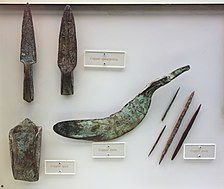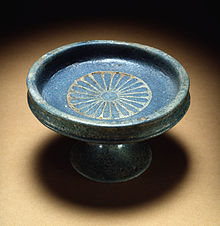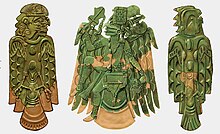User:Hylaversicolor/Copper
| This is the sandbox page where you will draft your initial Wikipedia contribution.
If you're starting a new article, you can develop it here until it's ready to go live. If you're working on improvements to an existing article, copy only one section at a time of the article to this sandbox to work on, and be sure to use an edit summary linking to the article you copied from. Do not copy over the entire article. You can find additional instructions here. Remember to save your work regularly using the "Publish page" button. (It just means 'save'; it will still be in the sandbox.) You can add bold formatting to your additions to differentiate them from existing content. |
Article Draft[edit]
Lead[edit]
copied and pasted from the copper main page article.
"Copper Age[edit][edit]
Main article: Copper Age
Copper smelting was independently invented in different places. It was probably discovered in China before 2800 BC, in Central America around 600 AD, and in West Africa about the 9th or 10th century AD. Investment casting was invented in 4500–4000 BC in Southeast Asia and carbon dating has established mining at Alderley Edge in Cheshire, UK, at 2280 to 1890 BC. Ötzi the Iceman, a male dated from 3300 to 3200 BC, was found with an axe with a copper head 99.7% pure; high levels of arsenic in his hair suggest an involvement in copper smelting. Experience with copper has assisted the development of other metals; in particular, copper smelting led to the discovery of iron smelting. Production in the Old Copper Complex in Michigan and Wisconsin is dated between 6000 and 3000 BC. Natural bronze, a type of copper made from ores rich in silicon, arsenic, and (rarely) tin, came into general use in the Balkans around 5500 BC.
Ancient and post-classical[edit]
In North America, copper mining began with marginal workings by Native Americans. Native copper is known to have been extracted from sites on Isle Royale with primitive stone tools between 800 and 1600. Copper metallurgy was flourishing in South America, particularly in Peru around 1000 AD. Copper burial ornamentals from the 15th century have been uncovered, but the metal's commercial production did not start until the early 20th century.[citation needed]"
notes for myself[edit]
I essentially only want to edit the history section (copper age & ancient and post-classical) of the copper page and expand upon the relatively little known history of copper usage by very early north American indigenous peoples starting approximately 10,000 years ago. I want to include these additions to the history section of the main copper page because currently the history section is biased towards Eurasia and does not represent historically marginalized peoples from around the world. I understand why this is the case as most of our recorded history comes from this region of the world but as new finding from North America challenge traditional perspectives I feel that the history section should be as up to date and unbiased as possible, reflecting the true historical use of copper globally. I could also talk about the timeline of NA at the time and ice sheets and glacial lakes (Agassiz) could have physically created a barrier or covered the great lakes until 10,000 years ago. Although speculative the inhabitants of North America at the time may not have been able to reach the native copper and the rich deposits around the great lakes that were mined until the glaciers receded exposing weathered outcrops in a tundra-like environment where modern day Michigan, Wisconsin and Ontario are now located until 10,000 years ago, If glaciers receded earlier the inhabitants could have used the copper earlier. Essentially they were only able to start using copper 10,000 years ago because the area was blocked by ice sheets before that time.
There are many opportunities to improves linkages between the main copper page and the following pages;
Metallurgy in pre-Columbian America
Metallurgy in pre-Columbian Mesoamerica
Archaic period (North America)
Article body[edit]
Copper Age[edit]
The earliest evidence of lost-wax casting in copper comes from an amulet found in Mehrgarh, Pakistan and is dated to 4000 BC.[1]

the use of copper in the Americas by indigenous peoples might go back further than once thought[2]Production in the Old Copper Complex in Michigan and Wisconsin is dated between 6500 and 3000 BC.[3] Copper usage by indigenous peoples around the Great Lakes region of North America might have occurred as far back as 9,500 years ago.[3][4] A copper spearpoint found in Wisconsin has been dated to 6500 BC,[3] potentially making it one of the oldest copper objects in the world. Currently the oldest known copper artifact is a pendant found in Iraq dating to 8700 BC. Indigenous peoples of North America around the Great Lakes may have also been mining copper during this time, making it one of the oldest known examples of copper extraction in the world.[5] There is evidence from prehistoric lead pollution from lakes in Michigan that people in the region began mining copper c. 6000 BC.[3]
Bronze Age[edit]

Egyptian Blue, or cuprorivaite (calcium copper silicate) was a synthetic pigment that contained copper and began being used in ancient Egypt around 3250 BC.[6] The manufacturing process of Egyptian blue was known to the Romans, but by the fourth century AD the pigment fell out of use and the secret to its manufacturing process became lost. The Romans said the blue pigment was made from copper, silica lime and natron and was known to them as caeruleum.
In North America evidence suggests that utilitarian copper objects fell increasingly out of use in the Old Copper Complex of North America during the Bronze Age and a shift towards an increased production of ornamental copper objects occurred.[7]
Ancient and post-classical[edit]

In North America, native copper is known to have been extracted from sites on Isle Royale with primitive stone tools between 800 and 1600 AD. Annealing of copper was being performed in the North American city of Cahokia around 1000-1300 AD.[8] There are several exquisite copper plates, known as the Mississippian copper plates that have been found in North America in the area around Cahokia dating from this time period (1000-1300 AD).[8] The copper plates were thought to have been manufactured at Cahokia before ending up elsewhere in the Midwest and southeastern United States like the Wulfing cache and Etowah plates.
In South America a copper mask dated to 1000 BC found in the Argentinian Andes is the oldest known copper artifact discovered in the Andes.[9] Peru has been considered the origin for early copper Metallurgy in pre-Columbian America, but this copper mask from Argentina suggests that the Cajon valley of the southern Andes was another important center for early copper metal workings in South America.[9]
talk about Mesoamerican copper production
notes for myself[edit]
In North America, copper mining began with marginal workings by Native Americans. Native copper is known to have been extracted from sites on Isle Royale with primitive stone tools between 800 and 1600. This sentence might need to be reworked as the latest published findings seem to contradict this statement. Mining copper in North America might have begun 9500 years ago.
I would like to add one photograph to the copper age section in the copper page, a photograph of artifacts from the Old copper complex. I would like to add a second photograph to the ancient and post-classical section of the copper page and include a photograph of the exquisite copper plates being produced around Cahokia at this time. I want to include these images on the main copper page because every image included in the history section of the copper page is from Europe or the Middle East. The history section of the copper page seems to underrepresent other copper producing cultures from around the world, including indigenous peoples of North America.
References[edit]
- ^ Thoury, M.; Mille, B.; Séverin-Fabiani, T.; Robbiola, L.; Réfrégiers, M.; Jarrige, J.-F.; Bertrand, L. (2016-11-15). "High spatial dynamics-photoluminescence imaging reveals the metallurgy of the earliest lost-wax cast object". Nature Communications. 7: 13356. doi:10.1038/ncomms13356. ISSN 2041-1723. PMC 5116070. PMID 27843139.
- ^ Pompeani, David P.; Abbott, Mark B.; Steinman, Byron A.; Bain, Daniel J. (2013-05-14). "Lake Sediments Record Prehistoric Lead Pollution Related to Early Copper Production in North America". Environmental Science & Technology. 47 (11): 5545–5552. doi:10.1021/es304499c. ISSN 0013-936X.
- ^ a b c d Pompeani, David P.; Steinman, Byron A.; Abbott, Mark B.; Pompeani, Katherine M.; Reardon, William; DePasqual, Seth; Mueller, Robin H. (2021-04). "ON THE TIMING OF THE OLD COPPER COMPLEX IN NORTH AMERICA: A COMPARISON OF RADIOCARBON DATES FROM DIFFERENT ARCHAEOLOGICAL CONTEXTS". Radiocarbon. 63 (2): 513–531. doi:10.1017/RDC.2021.7. ISSN 0033-8222.
{{cite journal}}: Check date values in:|date=(help) - ^ Bebber, Michelle R.; Buchanan, Briggs; Holland-Lulewicz, Jacob (2022-04-26). "Refining the chronology of North America's copper using traditions: A macroscalar approach via Bayesian modeling". PLOS ONE. 17 (4): e0266908. doi:10.1371/journal.pone.0266908. ISSN 1932-6203. PMC 9041870. PMID 35472064.
{{cite journal}}: CS1 maint: PMC format (link) CS1 maint: unflagged free DOI (link) - ^ Malakoff, David (19 March 2021). "Ancient Native Americans were among the world's first coppersmiths". www.science.org. Retrieved 2023-03-17.
- ^ Eastaugh, Nicholas; Walsh, Valentine; Chaplin, Tracey; Siddall, Ruth (2013-06-17). "Pigment Compendium: Optical Microscopy of Historical Pigments". doi:10.4324/9780080454573.
{{cite journal}}: Cite journal requires|journal=(help) - ^ Bebber, Michelle R.; Eren, Metin I. (2018-10-01). "Toward a functional understanding of the North American Old Copper Culture "technomic devolution"". Journal of Archaeological Science. 98: 34–44. doi:10.1016/j.jas.2018.08.001. ISSN 0305-4403.
- ^ a b Chastain, Matthew L.; Deymier-Black, Alix C.; Kelly, John E.; Brown, James A.; Dunand, David C. (2011-07-01). "Metallurgical analysis of copper artifacts from Cahokia". Journal of Archaeological Science. 38 (7): 1727–1736. doi:10.1016/j.jas.2011.03.004. ISSN 0305-4403.
- ^ a b Cortés, Leticia Inés; Scattolin, María Cristina (2017-06). "Ancient metalworking in South America: a 3000-year-old copper mask from the Argentinian Andes". Antiquity. 91 (357): 688–700. doi:10.15184/aqy.2017.28. ISSN 0003-598X.
{{cite journal}}: Check date values in:|date=(help)
